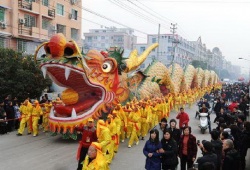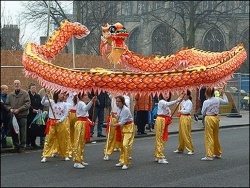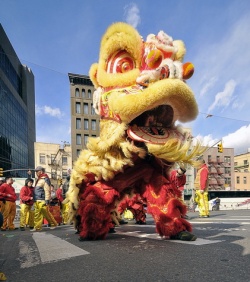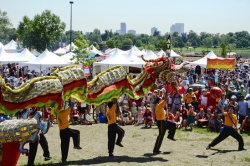Dragon dance
<poem>
Dragon dance (simplified Chinese: 舞龙; traditional Chinese: 舞龍; pinyin: wǔ lóng) is a form of traditional dance and performance in Chinese culture. Like the lion dance it is most often seen in festive celebrations. Many Chinese people often use the term "Descendants of the Dragon" (龍的傳人 or 龙的传人, lóng de chuán rén) as a sign of ethnic identity, as part of a trend started in the 1970s. Another derivation is from (農的傳人) i.e. the descendants of Shennong, the legendary first king of the Chinese people who taught them agriculture, law and medicine, the foundations of civilization.
The dance team mimics the supposed movements of this river spirit in a sinuous, undulating manner. The movements in a performance traditionally symbolise historical roles of dragons demonstrating power and dignity. The dragon dance is a highlight of Chinese New Year celebrations held worldwide in Chinatowns around the world.
Dragons are believed to bring good luck to people, which is reflected in their qualities that include great power, dignity, fertility, wisdom and auspiciousness. The appearance of a dragon is both frightening and bold but it has a benevolent disposition, and so eventually became an emblem to represent imperial authority.
History
Lion dances originated in India along with Buddhist lore and ritual. The popular form of lion dancing today's Chinese culture evolved in China, though several countries throughout the Asian region, including Japan, have developed their own styles of lion dance through the centuries.
The Dragon Dance itself originated during the Han Dynasty and was started by the Chinese who had shown great belief and respect towards the dragon. It is believed to have begun as part of the farming and harvest culture, also with origins as a method of healing and preventing sickness. It was already a popular event during the Song Dynasty where it had become a folk activity and like the lion dance, was most often seen in festive celebrations.
As the dragon gives people a feeling of great respect, it is often called the Sacred Dragon. The emperors of ancient China considered themselves as the dragon. The Dragon is also the emblem of Imperial Authority. It symbolizes supernatural power, goodness, fertility, vigilance and dignity.
In the Qing Dynasty, the Dragon Dance team of the province of Foochow had been invited to perform in Peking and had been greatly praised and admired by the Qing Emperor, which earned great fame for the team.
Performance
The dragon dance is performed by a skilled team whose job is to bring the motionless body to life. The dragon itself is a long serpent shaped body on poles, assembled by joining the series of hoops on each section and attaching the ornamental head and tail pieces at the ends. Traditionally, dragons were constructed of wood, with bamboo hoops on the inside and covered with a rich fabric, however in the modern era lighter materials such as aluminium and plastics have replaced the wood and heavy material.
Dragons can range in length from around 25 to 35 meters for the more acrobatic models, and up to 50 to 70 meters for the largest, parade and ceremonial styles, since part of the myth of the dragon is that the longer the creature, the more luck it will bring. The size and length of a dragon depend on the human power available, financial power, materials, skills and size of the field. Its length typically ranges from 9 sections to 15 sections long, though some dragons are as long as 46 sections.
A small organization cannot afford to run a very long dragon because it consumes great human power, great expenses and special skills which are difficult to manage. The normal length and size of the body recommended for the dragon is 112 feet (34 meters) and is divided into 9 major sections. The distance of each minor (rib-like) section is 14 inches apart; therefore, the body has 81 rings. History tells us that the dragon dance is performed in various ways, types and colors. Green is sometimes selected as a main color of the dragon, which symbolizes a great harvest. Other colors include: yellow symbolizing the solemn empire, golden or silver colors symbolizing prosperity, red color representing excitement while its scales and tail are mostly beautiful silver colors and glittering at all times which provides a feeling of joyous atmosphere. As the Dragon dance is not performed every day, the cloth of the dragon is to be removed and to have a new touch of ultra-paint before the next performance.
The correct combination and proper timing of the different parts of the dragon are very important to make a successful dance. Any mistakes made by even some of the performers would spoil the whole performance. To be very successful in the dance, the head of the Dragon must be able to co-operate with the body in combination with the timing of the drum. For larger ceremonial and parade style dragons, the head can weigh as much as 12 katis (14.4 kg, almost 32 lb). The dragon tail also has an important role to play as it will have to keep in time with head movements. The fifth section is considered to be the middle portion and the performers must be very alert as the body movements change from time to time.
In competition performances however, there are strict rules governing the specifications of the dragon body and the routine performed, and so dragons made for these events and what are mostly seen in the impressive stage shows are made for speed and agility, to be used by the performing team for maximum trick difficulty. In these dragons, the head is smaller and light enough to be whipped around, and must be a minimum of 3 kg, the body pieces are a light aluminium with cane and the majority of the hoops will be very thin PVC tubing. Performances are typically made into 8-10 minute routines with an accompanying percussion set.
A double dragon dance, rarely seen in Western exhibitions, involves two troupes of dancers intertwining the dragons. Even rarer are dances with the full array of nine dragons, since nine is a "perfect" number. Such dances involve large number of participants from various organizations, and are often only possible under the auspices of the greater community.
The patterns of the dragon dance are choreographed according to the skills and experiences acquired by the performers. Some of the patterns of the dragon dance are "Cloud Cave", "Whirlpool", T'ai chi pattern, "threading the money", "looking for pearl", and "dragon encircling the pillar". The movement "dragon chasing the pearl" shows that the dragon is continually in the pursuit of wisdom.
The dragon moves in a wave-like pattern achieved by the co-ordinated swinging of each section in succession. Whilst this swinging constitutes the basic movement of the dragon, executing more complex formations is only limited by a team’s creativity. The patterns and tricks that are performed generally involve running into spiralled formations to make the dragon body turn and twist on itself. This causes performers to jump over or through the dragon’s body sections, adding to the visual display. Other advanced manoeuvres include various corkscrew-like rotating tricks and more acrobatic moves where the performers stand on each other's legs and shoulders to increase the height of the dragon’s movements.
Performing in a dragon dance team incorporates several elements and skills; it is something of a cross-over activity, combining the training and mentality of a sports team with the stagecraft and flair of a performing arts troupe. The basic skills are simple to learn, however to become a competent performer takes dedicated training until movements become second nature and complex formations can be achieved – which rely not only on the skill of the individual member, but on concentration by the team as a whole to move in co-operation.
In literature
Lawrence Ferlinghetti's poem "The Great Chinese Dragon", published in his 1961 anthology Starting from San Francisco was inspired by the dragon dance. Gregory Stephenson says the dragon "… represents 'the force and mystery of life,' the true sight that 'sees the spiritual everywhere translucent in the material world.'" Earl Lovelace's novel "The dragon can't dance" uses the theme of the Carnival dance to explore social change and history in the West Indies.



